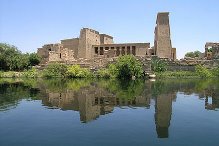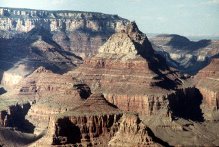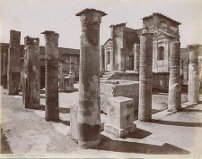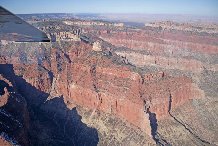Isis
Isis is one of the earliest and most important goddess in ancient Egypt. She was regarded as the feminine counterpart to Osiris, a role she probably occupied before the dawn of dynastic Egypt. No other Egyptian deity has stood the test of time as well as Isis. Her cult was not extinguished with the other Egyptian gods, but was embraced by the Greeks and Romans, her worship has even lasted into the present day.
 She was revered by the Egyptian people as the great mother-goddess and represents the maternal spirit in its most intimate form. She is often seen suckling a young Horus. In the Osiris legend she is seen as a dutiful wife, a grieving widow and as a protector of the dead.
She was revered by the Egyptian people as the great mother-goddess and represents the maternal spirit in its most intimate form. She is often seen suckling a young Horus. In the Osiris legend she is seen as a dutiful wife, a grieving widow and as a protector of the dead.
As a winged goddess she may represent the wind. In the Osiris legend there are references to Isis wailing and moaning like the wind. She is also continually travelling up and down the land in search of her lost husband. Upon finding Osiris’ body, she takes the shape of one of the swiftest birds, a kite. Flapping and darting above his dead body she wails in mourning. She restores life to Osiris by flapping her wings and filling his mouth and nose with air.
Isis was a great enchantress, the goddess of magic. Together with Thoth, she taught mankind the secrets of medicine. She was the embalmer and gaurdian of Osiris. She is often rendered on the foot of coffins with long wings spread to protect the deceased.
Philae temple (Aswan)
Isis temple is perched on the island of Philae (100 km from Aswan south of Egypt) After the building of the old Aswan Dam, the temple was swamped for six months of every year by the high waters, allowing travelers to take rowing boats and glide among the partially submerged columns to peer down through the translucent green at the wondrous sanctuaries of the mighty gods below. After the completion of the High Dam, the temple would have entirely disappeared had Unesco not intervened. Between 1972 and 1980, the massive temple complex was disassembled stone by stone. It was then reconstructed 20m higher on nearby Agilika Island, which was landscaped to resemble the original sacred isle of Isis.
The Temple of Isis in Pompeii
The Temple of Isis is a Roman temple dedicated to the Egyptian goddess Isis. This small and almost intact temple was among one of the first discoveries during the excavation of Pompeii in 1764. Its role as a Hellenized Egyptian temple in a Roman colony was fully confirmed with an inscription detailed by Francisco la Vega on July 20, 1765. Original paintings and sculptures can be seen at the Museo Archaeologico in Naples; the site itself remains on the Via del Tempio di Iside. In the aftermath of the temple’s discovery many well-known artists and illustrators swarmed to the site. The preserved Pompeian temple is actually the second structure; the original building built during the reign of Augustus was damaged in an earlier earthquake of 62 AD. Seventeen years later with the massive volcanic eruption, the Iseum alone was the sole temple to be completely re-built – ahead even of the Capitolium.
Isis temple – Grand Canyon, USA
 In this section we reach a mysterious point. According to some researchers, a pyramid and an Isis temple had been found in the American Canyon! In this link, the author is asking about ancient Egyptian treasures which had been found in the Grand Canyon. On April 5th, 1909, there appeared a front page story in the Arizona Gazette. It told of an archeological expedition in the heart of the Grand Canyon funded by the Smithsonian Institute. It is a rich story of finding a labyrinth of man-made tunnel systems high above the Colorado River, a virtual citadel filled with ancient artifacts, hieroglyphs, armor, statues of deities and even mummies. Anyone contacting the Smithsonian Institute will receive a polite “no records found” reply to an inquiry about their supposed role in the Grand Canyon.
In this section we reach a mysterious point. According to some researchers, a pyramid and an Isis temple had been found in the American Canyon! In this link, the author is asking about ancient Egyptian treasures which had been found in the Grand Canyon. On April 5th, 1909, there appeared a front page story in the Arizona Gazette. It told of an archeological expedition in the heart of the Grand Canyon funded by the Smithsonian Institute. It is a rich story of finding a labyrinth of man-made tunnel systems high above the Colorado River, a virtual citadel filled with ancient artifacts, hieroglyphs, armor, statues of deities and even mummies. Anyone contacting the Smithsonian Institute will receive a polite “no records found” reply to an inquiry about their supposed role in the Grand Canyon.
Photo gallery
The attached photo Canyon1 comment: The view we got from the hidden and secret view point (we call it Monty’s Point) was fantastic and indescribable. With the 75-300 zoom I took Isis Temple which is located at a distance of 5 kilometers from this point.
The attached photo Canyon2 comment
The gigantic butte known as the Vishnu Temple, as seen from Grandview Point. The temple itself is carved from the Coconino Sandstone. Below it you can see the Hermit Formation, Supai Group, and Redwall Limestone. All around the temple, other smaller buttes have also been carved from the rock.
Videos
[tentblogger-youtube gYtd_X5fsIw]
[tentblogger-vimeo 70075922]
This video shows that the star pattern of ORION, the Hunter Constellation, lines up with the Monuments of the Grand Canyon such as Isis Temple. This is proof that while they appear natural, they’re most likely not and were built pre Deluge.
Did the Egyptians cross the Atlantic Ocean?
Lot of researches had been undertaken to find a hidden connection between Maya and Egyptian Pyramids. In 1970, Thord Heyerdahl succeeded to cross the Atlantic Ocean with a papyrus boat. This is the story of Hyyerdahl:
Thor Heyerdahl expedition
Thor Heyerdahl was a Norwegian ethnographer and adventurer with a background in zoology, botany, and geography. He became notable for his Kon-Tiki expedition in 1947, in which he sailed8,000 km (5,000 mi) across the Pacific Ocean in a hand-built raft from South America to the Tuamotu Islands.
Boats Ra and Ra II
In 1969 and 1970, Heyerdahl built two boats from papyrus and attempted to cross the Atlantic Ocean from Morocco in Africa. Based on drawings and models from ancient Egypt, the first boat, named Ra (after the Egyptian Sun god), was constructed by boat builders from Lake Chad using papyrus reed obtained from Lake Tana in Ethiopia and launched into the Atlantic Ocean from the coast of Morocco.
After a number of weeks, Ra took on water after its crew made modifications to the vessel that caused it to sag and break apart after sailing more than 4000 miles. The crew was forced to abandon Ra some hundred miles before Caribbean islands and was saved by a yacht.
The following year, 1970, another similar vessel, Ra II, was built of papyrus by Demetrio, Juan and Jose Limachi from Lake Titicaca in Bolivia and likewise set sail across the Atlantic fromMorocco, this time with great success. The crew was mostly the same.
The book The Ra Expeditions and the film documentary Ra (1972) were made about the voyages. Apart from the primary aspects of the expedition, Heyerdahl deliberately selected a crew representing a great diversity in race, nationality, religion and political viewpoint in order to demonstrate that at least on their own little floating island, people could cooperate and live peacefully. Additionally, the expedition took samples of marine pollution and presented their report to the United Nations.]
Isis
Iside è una delle più antiche e importanti divinità in Egitto. E’ stata considerata la controparte femminile di Osiride, un ruolo che probabilmente occupava prima dell’alba dell’Egitto dinastico. Nessun’altra divinità egizia ha resistito alla prova del tempo come Iside. Il suo culto non si è estinto con le altre divinità egizie, ma è stato abbracciato dai Greci e dai Romani, il suo culto è anche durato fino ai giorni nostri. E’ stata venerata dal popolo egiziano come la grande dea-madre e rappresenta lo spirito materno nella sua forma più intima. Lei è spesso vista che allatta il giovane Horus. Nella leggenda Osiride è vista come una moglie obbediente, una vedova in lutto e come protettore dei morti. Come una dea alata che può rappresentare il vento. Nella leggenda di Osiride ci sono riferimenti al pianto e al gemito di Iside come il vento. Lei è anche continuamente in viaggio su e giù per il paese alla ricerca del marito perduto.
Il tempio di Aswan
Il tempio di Iside si trova sull’isola di Philae ( a 100 km a sud dell’Egitto). Dopo la costruzione della vecchia diga di Aswan il tempio era sommerso per sei mesi all’anno dalle acque alte e consentivano ai viaggiatori di riprendere le barche e navigare tra le colonne parzialmente sommerse attraverso santuari sott’acqua. Dopo il completamento della diga alta il tempio sarebbe completamente scomparso se non fosse intervenuto l?Unesco. Tra il 1972-1980 il complesso del tempio fu smembrato pietra su pietra e poi ricostruito venti metri più alto vicino all’isola di Agilicah che era il panorama che più assomigliava alla sacra isola originaria di Isis.
Il tempio di Isis a Pompei
 Il tempio di Isis è un tempio romano dedicato alla divinità egiziana Isis. Questo tempio piccolo e abbastanza intatto è uno delle prime scoperte fatte durante gli scavi di Pompei nel 1764. Il suo ruolo come tempio egiziano ellenizzato in una colonia romana venne pienamente riconfermato dal ritrovamento di una iscrizione da parte di Francisco La Vega, il 20 luglio 1765. Scritture e pitture originario possono essere viste al museo Archeologico di Napoli. Il sito stesso rimane nella via del Tempio di Iside. Subito dopo la scoperta del tempio molti artisti noti e illustratori si recavano in visita al sito. Il tempio pompeiano conservato è attualmente la seconda struttura. L’edificio originale costruito durante il regno di Augusto venne danneggiato durante un terremoto nel 62 A.C. Diciassette anni dopo, con l’eruzione del vulcano, l’Iseo fu il solo tempio a essere interamente ricostruito.
Il tempio di Isis è un tempio romano dedicato alla divinità egiziana Isis. Questo tempio piccolo e abbastanza intatto è uno delle prime scoperte fatte durante gli scavi di Pompei nel 1764. Il suo ruolo come tempio egiziano ellenizzato in una colonia romana venne pienamente riconfermato dal ritrovamento di una iscrizione da parte di Francisco La Vega, il 20 luglio 1765. Scritture e pitture originario possono essere viste al museo Archeologico di Napoli. Il sito stesso rimane nella via del Tempio di Iside. Subito dopo la scoperta del tempio molti artisti noti e illustratori si recavano in visita al sito. Il tempio pompeiano conservato è attualmente la seconda struttura. L’edificio originale costruito durante il regno di Augusto venne danneggiato durante un terremoto nel 62 A.C. Diciassette anni dopo, con l’eruzione del vulcano, l’Iseo fu il solo tempio a essere interamente ricostruito.
Terzo tempio di Isis- Grand Canyon, Usa
In questa seconda sezione noi raggiungiamo un punto misterioso. Secono alcuni ricercatori una piramide e un tempio di Isis sono stati ritrovati anche nel Gran Canyion americano. In questo link l’autore chiede dei tesori egiziani trovati nel Grand Canyon. Il 5 aprile 1909 in prima pagina sull’ Arizona Gazette siriportava di una spedizione archeologica condotta nel cuore del Grand Canyon finanziata dall’istituto Smithsonian Institute. E la storia è una storia ricca del ritrovamento di un labirinto, un sistema di tunnel fatti dall’uomo, sopra il fiume Colorado, una cittadella virtuale piena di antiche artefatte geroglifici, armature, statue di divinità e mummie. Contattando l’istituto Smithsonian per saperne di più si riceverà la risposta educata: non è stato trovato niente.
Foto Gallery
La vista che noi abbiamo da quetsa angolazione segreta e coperta era fantastica e indescrivinile. Con 75-300 zoom io ho ripreso il tempio di Isis che si trova a una distanza di 5 km da questo punto. Il gigantesco luogo conosciuto come tempio di Visnou. Visto da un punto grandangolare il tempio stesso è ricavato dalla pietra sabbiosa di Coconì. Sotto potete vedere la formazione Hermit, il gruppo Supai, Redwall Limestone. Tutto intorno al tempio altri piccole costruzioni sono state ricavate nella roccia.
Video
 Questo video mostra che la stella di Orione è allineata con i monumenti del Grand Canyon come pure del tempio di Isis. Questa è la prova che furono costruiti prima del diluvio.
Questo video mostra che la stella di Orione è allineata con i monumenti del Grand Canyon come pure del tempio di Isis. Questa è la prova che furono costruiti prima del diluvio.
Gli egiziani attraversarono l’Oceano Atlantico?
Molti ricercatori sostengono che esistono connessioni nascoste tra Maya e piramidi egiziane. Nel 1970 Thord Heyerdahl riuscì ad attraversare l’Oceano Atlantico con una barca di papiro. Questa è la sua storia.
La spedizione di Thord Heyerdahl
T. H. era un etnografo e avventuriero norvergese con un background in botanica e geografia. Divenne noto per la sua spedizione Kon-Tiki nel 1947, nella quale navigò per 8000 km attraverso l’Oceano Pacifico in un raft fatto a mano partendo dal Sud America alle isole Tuamotu.
Le barche Ra e Ra II
Nel 1969 e 1970 H costruì due barche di papiro e tentò di attraversare l’Oceano Atlantico dal Marocco. Realizzata su disegni e modelli dell’antico Egitto, la prima barca, chiamata Ra, dal dio del sole egiziano, fu costruita da navigatori del lago del Chad usando foglie di papiro ottenute dal lago Tana in Etiopia e fu fatta partire dalle coste del Marocco. Dopo alcune settimane Ra cominciò a imbarcare acqua e si spezzò dopo aver navigato per circa 400 miglia. L’equipaggio f costretto ad abbandonarla adf alcune centinaia di miglia alle isole dei Caraibi e messo in salvo da uno yacht. L’anno seguente, 1970, un altro vascello simile, Ra II, fu costruito di papiro da Demetro, Juan e Jose Limachi dal lago di Titikaka e attraversò l’Atlantico con grande successo. Il libro “Le spedizioni Ra” e il film documentario “Ra” (1972) documentano questi viaggi. A prescindere dagli aspetti tecnici della spedizione, H deliberatamenbte selezionò un equipaggio che rappresentava una grande diversità di razze, nazionalità, religioni e punti di vista politici per dimostrare come su una piccola isola fluttuante la gente possa cooperare e vivere pacificamente. In aggiunta la spedizione raccolse campioni di inquinamento marino e presentò un rapporto alle Nazioni Unite.
Paul Attallah



